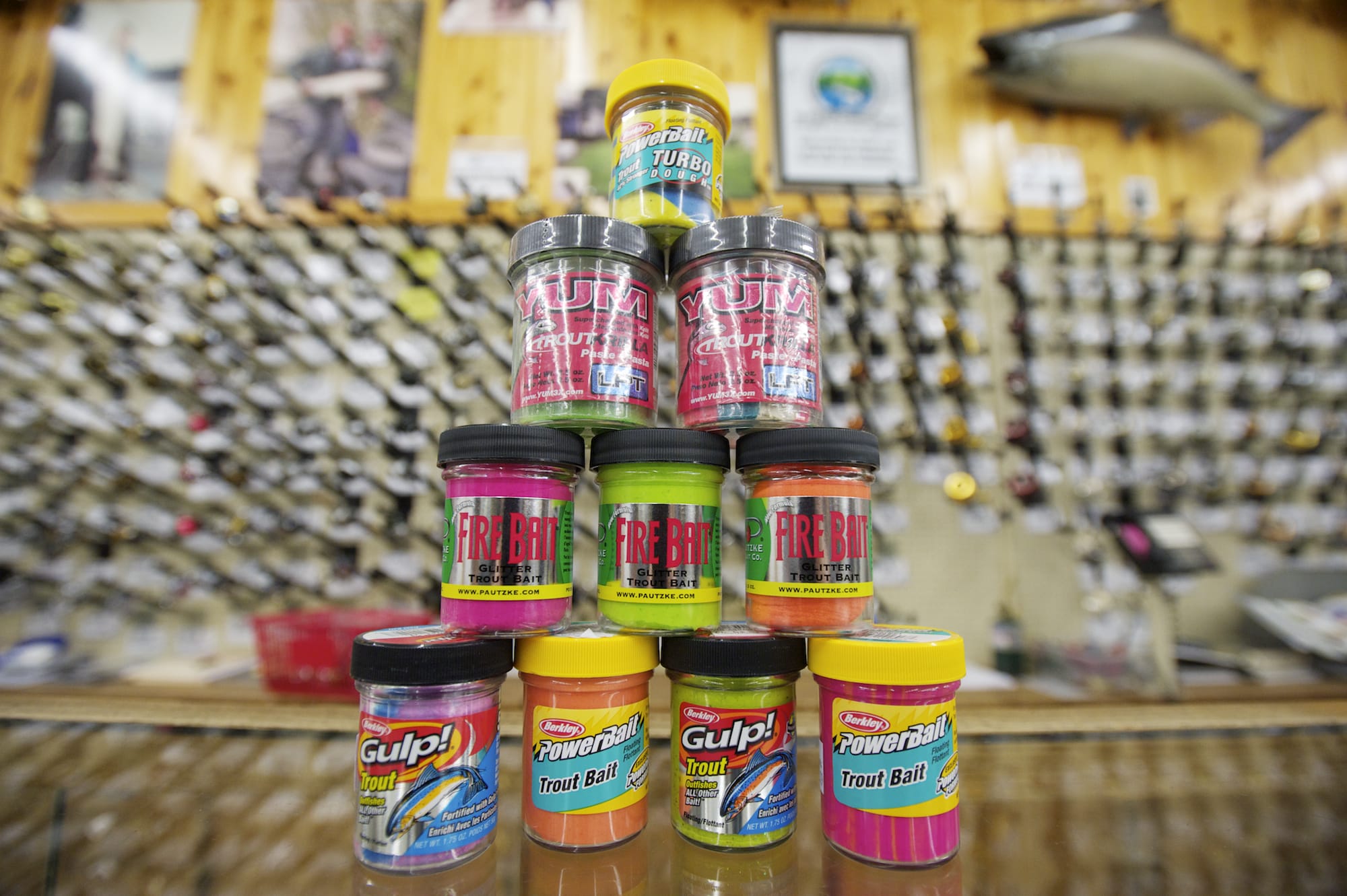When your desire is to put a rainbow trout in the frying pan, there might be no better way to catch one than using a dough bait.
The consistency of moist Play-Doh, packed with assorted scents, perhaps flecked with glitter and coming in a rainbow of colors, dough baits are a trout angler’s go-to bait.
The advantages of dough bait are numerous, said Tacoma-area angler Rick Drury.
It’s quick and easy to put on a hook. There is less of a mess than using worms. The small jars are easy to store. It comes in a multitude of colors and scents. It is easy to fish. Most importantly, dough baits put trout on your stringer.
“I have fished with dough bait for approximately 20 years,” Drury said. “It is a very effective bait when fished properly.”
Drury is a fan of Berkley’s Power Bait. He is not alone.
When it comes to dough bait, Power Bait dominates. It accounts for half of dough bait sales, said Rob Southwick, president of Southwick Associates Inc., which tracks that information for the trade group American Sportfishing Association.
In second is Berkley’s Gulp brand, accounting for 12 percent of sales.
Other brands include Eagle Claw’s Nitro Bait and TroutKrilla Paste from Yum.
A relative newcomer on the market is Pautzke Bait Co.’s Fire Bait. The Ellensburg company has had its product on the market for about two years, said Chris Shaffer, Pautzke’s director of operations.
The company made a dough bait in the 1980s, but it didn’t meet expectations. So staff researchers spent 20 years trying to find the right combination of color, scent, flotation and durability.
“We wanted to be sure when we came out with something that we came out with the perfect bait,” Shaffer said.
But Pautzke’s faces a daunting task of competing with Power Bait. Berkley came out with its top seller in the late 1980s.
“In the last 10 years, millions of people have tried to come out with something that competes with what Berkley does and have failed miserably,” Shaffer said. “Berkley has dominated that scene for so long.”
Dough baits haven’t always been at the top of trout baits. While worms have always been a favorite, salmon eggs were the popular off-the-shelf bait. Shaffer said there were 8 million jars of salmon eggs a year sold in the 1970s.
“Now dough baits really dominate the scene. The younger generation is just glued to the dough baits,” he said. “Berkley did a phenomenal job of getting the word out. I think dough baits are here to stay.”
One reason Drury made the switch is because he started catching bigger fish.
“I used to trout fish with worms and a bobber, but the trout were much smaller,” he said. “It seems that the larger trout tend to hold towards the bottom above the weeds, picking off easy meals.”
When fished properly, Drury said, dough baits float above the weeds, releasing a scent in the trout’s feeding zone.
Presentation, agreed Randy Anderson at Sportco, a sporting goods retailer, is the key to success.
“You want to make sure your leader is long enough to get above the weeds on the bottom, usually about 3 to 4 feet,” Anderson said.
A popular way to fish dough baits is to put a slip sinker over your main line and tie the line to a snap swivel. He will then tie a leader, in four- to six-pound test and long enough to get the bait
above any bottom weeds, to the swivel. Leaders will range from 12-30 inches. At the end of the leader is a small hook, typically from size 8-12.
You form the dough bait into a small ball — about the size of a marble — and cover the hook with the bait.
You then cast out the rig, allowing the sinker to fall to the bottom.
Then reel in the slack line and wait for a fish to take the bait as it floats above the bottom.
Using a slip sinker allows the line to pass through the sinker as fish begins to take the bait and before it feels the weight of the sinker, Anderson said.
“The presentation is extremely important,” Drury said. “I have seen people fish it with bobbers, on split shot (sinkers), even added to trolling gear.”
He fishes with a setup similar to what Anderson’s described.
“You have to watch your line. A lot of times, they will take it while it is falling,” he said.
Drury fishes with a semi-slack line. When the trout takes the bait, there will be little or no resistance as the line slides through the slip sinker.
“On numerous occasions, I have fished side by side with people who are not rigging the bait properly. Usually no fish will be caught if it’s not presented properly,” Drury said.
Drury tells the story of the first time he used Power Bait. He and a friend were fishing at Spanaway Lake. A man next to Drury quickly caught his limit while using Power Bait.
“He showed us what he was using and even offered us a jar. We proceeded to re-rig with what we had. We had the slip sinkers, but didn’t have the proper leaders,” Drury said. “We were fishing right
next to him and couldn’t buy a nibble. When he left, he gave us a couple of Gamakatsu leaders. Then we quickly caught our limit.
“I have seen this time and time again. The three keys are presentation, presentation, presentation.”



